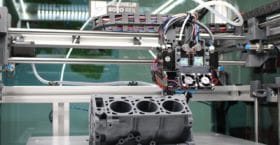
The incredible advances we’ve seen in medical devices and equipment over the last few decades are due in large part to specialty plastics and the development of medical machining. Precise CNC machining allows for a high degree of accuracy and repeatability, and can produce parts with extremely tight tolerances. Medical machining can also accommodate specialty […]
Read More »
Torlon® is a high-performance, non-crystalline engineering thermoplastic that provides reliable strength and performance at high temperatures. Its unique combination of properties makes it ideal for the most extreme and punishing environments, such as racecar engines and NASA’s space shuttles. At Reading Plastic, we have an excellent track record of producing precision parts that hold tight […]
Read More »
Conductive materials are able to move energy quickly and easily, which makes them a common choice for grounding materials. But ESd conductive plastics can be used in a wide range of applications that require dissipation of static charges or protection from electrostatic discharge (ESd). The Many Uses of ESd Conductive Plastics Increased safety in explosive […]
Read More »
Electrostatic discharge (ESd) materials are plastics that reduce static electricity in order to protect electrostatic-sensitive devices or to contain flammable liquids or gases. These materials are divided into three categories: anti-static, conductive, and static-dissipative materials. ESd materials are classified by how quickly electricity moves through the material, with that speed referred to as the “resistance” […]
Read More »
A comprehensive ESD material list includes materials from all four categories: insulative, anti-static, dissipative, and conductive. Conductive materials have a low electrical resistance, allowing electrons to flow easily across the surface of or through these materials, providing a path for charge to bleed off. The charges go to ground or to another conductive object that […]
Read More »
Those unfamiliar with the term additive manufacturing may know it by the more popular phrase, 3D printing. Additive manufacturing encompasses all technologies that build 3D objects by adding material layer upon layer. These technologies include 3D printing, direct digital manufacturing, layered manufacturing, additive fabrication, and rapid prototyping. Additive manufacturing, when used as a compliment to […]
Read More »
PPS (polyphenylene sulfide) is a semicrystalline material that is often used for applications that involve exposure to corrosive chemicals at elevated temperatures. That is because PPS material offers the broadest resistance to chemicals of any advanced engineering plastic, with no known solvents below 392°F (200°C). Combined with outstanding mechanical properties and excellent resistance to hot […]
Read More »
Nuclear energy is responsible for 11% of the world’s electricity, and is the second-largest source of low-carbon energy worldwide. The efficiency, operation and safety of these plants is dependent upon the quality of the components they are comprised of, and often it is the smallest components of nuclear power plants that get overlooked. During the […]
Read More »
When it comes to high performance engineering thermoplastics, PEI plastic offers a great balance of mechanical properties and processability that makes it suitable for use in a wide range of applications. With high strength and stability and a glass transition temperature of 420º, PEI plastic is a lower cost alternative to PEEK. Its long term […]
Read More »
Electrostatic discharge (ESd) materials are plastics designed to reduce static electricity in order to protect electrostatic-sensitive devices or contain flammable liquids or gases. These plastics come in varying degrees, two of which are antistatic and static dissipative. Understanding antistatic vs. static dissipative plastics will help you choose the right material for your application. Why Antistatic […]
Read More »
From bearings to semiconductors, industrial plastic parts require a high degree of quality and precision. Since 1978, Reading Plastic Machining & Fabrication has been a trusted provider of high-end machined plastics across multiple industries. We machine the world’s most advanced plastics for both private and government clients, and are accustomed to meeting the regulatory requirements […]
Read More »
The term “radiation” encompasses the whole broad spectrum of electromagnetic wavelengths – from long radio waves to extremely short gamma rays – as well as ionizing radiation. Knowing the types of radiation your plastic components will be exposed to will help you choose the plastic material with the appropriate degree of radiation resistance. Electromagnetic Radiation […]
Read More »